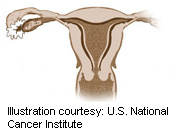
THURSDAY, May 20 (HealthDay News) — A step-wise approach accurately spots early stage ovarian cancer in older women at average risk for the disease, new research suggests.
This cancer is known as a silent killer because it is often diagnosed too late to be successfully treated. Scientists have long sought a reliable method of early detection.
The “Risk of Ovarian Cancer Algorithm” (ROCA), which uses a mathematical model, is geared specifically to postmenopausal women at average risk for the disease.
The findings will be presented at the annual meeting of the American Society of Clinical Oncology (ASCO), being held next month in Chicago, but were released to reporters at a special news briefing Thursday.
“This ROCA algorithm represents yet another example of personalized medicine. This is personalized towards a screening strategy for a vicious cancer,” explained Dr. Douglas W. Blayney, ASCO president, professor of internal medicine at the University of Michigan Medical School and medical director of the Comprehensive Cancer Center at the University of Michigan.
However, experts are awaiting the results of a much larger trial, due out in 2015, before recommending this as routine procedure.
“This is not practice-changing at this time,” said study lead author Dr. Karen Lu, professor of gynecologic oncology at the University of Texas M.D. Anderson Cancer Center.
“Ovarian cancer is the most lethal gynecologic cancer and the fourth leading cause of death in cancer in women,” Lu said. “Over 75 percent of cases present with advanced-stage disease, when the cure rate is less than 30 percent. There is no effective screening method at the current time.”
Measuring levels of a blood protein called CA-125 can help detect ovarian cancer, but the marker is far less than perfect.
This study involved more than 3,200 postmenopausal women, aged 50 to 74, who had not had ovarian cancer themselves and who had no significant family history of breast or ovarian cancer.
The women started off getting a CA-125 blood test every year. If the test indicated low risk, the women could wait another year before their next test.
If levels were elevated, putting them in an intermediate-risk category, however, the women were scheduled for a follow-up test in three months.
If that test was also high, the women were considered high risk and underwent transvaginal sonography (TVS) or ultrasound, and were referred to a gynecologic oncologist, who decided whether or not surgery was needed.
Over the nine years of the trial, 6.8 percent of the volunteers were bumped up to the three-month CA-125 test group, while only 1 percent were referred to TVS and a cancer specialist.
In total, eight of the more than 3,200 women underwent the recommended surgery. Three of those had invasive early-stage cancer (the three had undergone three years of annual CA-125 testing before moving to the next group), two had “borderline” ovarian tumors and the remaining three had benign ovarian tumors.
The specificity of the ROCA method was 99.7 percent, meaning there were virtually no false-positives, the team noted.
No women with invasive ovarian cancer were missed by the test, Lu said.
If results of the larger ROCA trial, currently underway in Britain, are encouraging, ROCA may be coming to a doctor’s office in the not too distant future, “part of the routine health exam for postmenopausal women,” Blayney said.
More information
Find out more on ovarian cancer at the U.S. National Cancer Institute.

